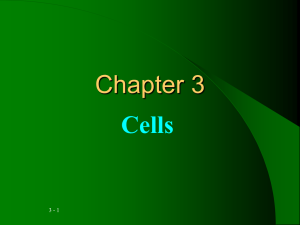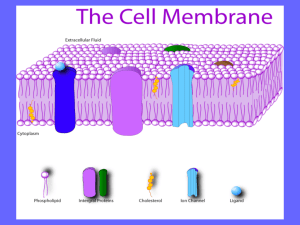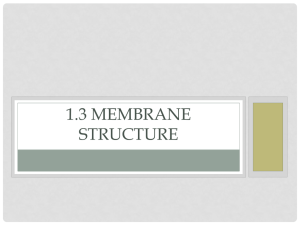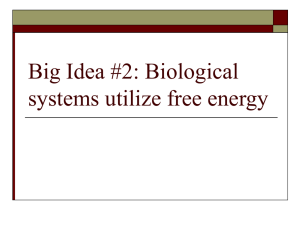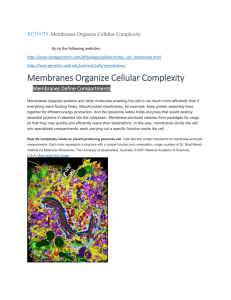Membrane Modelling?
advertisement
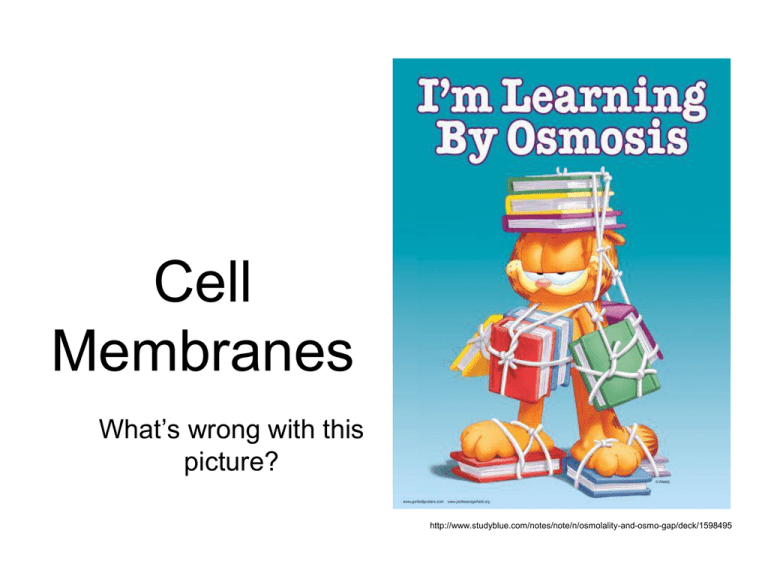
Cell Membranes What’s wrong with this picture? http://www.studyblue.com/notes/note/n/osmolality-and-osmo-gap/deck/1598495 The Plasma Membrane • • • • Membranes Cells separate “inside and outside” with lipid barriers called membranes. Organelle membranes separate too. Limits passage of polar substances. Protein channels allow specific passage. BILL: What is the difference between polar and charged? What passes freely? • • • Small, uncharged polar molecules Small nonpolar molecules like N2 Model simple diffusion http://www.studyblue.com/notes/note/n/biology-172-lecture-7-flashcards/deck/124266 Cell Walls • • • • Are outside the membrane Structural Plant cell walls are made of cellulose Prokaryotes and fungi also have cell walls. http://www.phschool.com/science/biology_place/biocoach/plants/walls.html Phospholipid Bilayer • This represents a phospholipidPolar head-Hydrophilic-label Nonpolar tail-Hydrophobiclabel • The tails are fatty acid, the head, phosphorylated alcohol • These form a sheet two molecules thick. http://en.wikipedia.org/wiki/Phospholipid Why the embedded cholesterol? What might a membrane in an arctic dweller look like? Increase or decrease fluidity depending on temperature.(Decreases fluidity when warm, increases fluidity when cold…keeps membranes fluid at very cold temperatures) Membrane Proteins Function in • Transport• Enzyme • Surface receptors • ID Markers • Cell-cell connection • Attachment http://www.pc.maricopa.edu/Biology/pfinkenstadt/BIO201/201LessonBuilder/UnitOne/Membrane/in Embedded Proteins • • Can be hydrophilic with charges and polar side groups or… Hydrophobic, with nonpolar Place your proteins in the membrane. http://www.uic.edu/classes/bios/bios100/lecturesf04am/lect08.htm Anchoring in the membrane What could keep proteins in the membrane? Transmembrane Proteins •Carriers- change shape –Active and passive transport –Sodium potassium pump •Channels–are tunnels through the hydrophobic core •Receptors –Transmit information from the outside of the cell –Hormone receptors, neurotransmitters. What needs a channel? Hydrophilic substance like large polar molecules and ions http://www.cipsm.de/en/publications/researchAreaF/2007/index.html Carrier proteins •Holds ion or molecule •Changes shape Have you seen shape changes before? •To move something across the membrane Green ball is one K+ in a potassium pump Campbelll p 125 8th edition. Aquaporins •Channel Protein •Each aquaporin allows 3 billion water molecules per second to pass into the cell single file. What might the positively charged region do? http://www.bio.miami.edu/~cmallery/150/me mb/water.channels.htm Receptor Proteins •Example: –G protein linked receptor –neurotransmitter • Cell Surface Markers Glycoproteins- a carbohydrate combined with a protein. Add a carbohydrate chain to a protein embedded in the membrane. Add and label Important in the self recognition. Recognized by the immune system. • Glycolipid- a carbohydrate combined with a lipid . Add a carbohydrate to a lipid. Add and label. Important in tissue recognition. Example is blood group marker. Cell surface markers Glycocalyx- “Sugar coating” Me You •Glycoproteins- “self” recognition The protein/carbohydrate chain shape is different person to person. For example, the major histocompatibility complex proteins are recognized by the immune system. •Glycolipids-tissue recognition The lipid/carbohydrate chain shape is specific for a certain Transport Modes Through the cell membrane • • Passive - Down the concentration gradient-primary role in importing resources and exporting waste 1. Diffusion 2. Facilitated Diffusion- membrane proteins help charged and polar molecules pass. 3. Osmosis Active- Against the concentration gradient. Energy requiring. Requires membrane proteins. 1. Endocytosis/Exocytosis 2. Na+/K+ Pump 3. Proton Pump Diffusion •Often by Ion Channels •Direction of movement determined by –Relative concentration –Voltage •Each channel is specific for one or a few ions •Nervous system Facilitated Diffusion •Carrier Proteins •Specific also •Bind/release •Moves things down the concentration gradient •Passive transport •Can become saturated Active Transport •Uses Energy •Moves things against the gradient •Na/K Pump •Coupled Transport –Gradients created by one process can power another Sodium Potassium Pump • • • • • Cytoplasmic Na+ binds (high affinity in this shape). Na+ binding stimulates phosphorylation by ATP Phosphorylation causes shape change, lower Na+ affinity, now high K+ affinity. The K+ binding causes phosphate to be released Phosphate release causes shape to return. Now low K+ affinity, Endocytosis and Exocytosis • Exocytosis-internal vesicles fuse with the plasma membrane to release large macromolecules out of the cell. • Endocytosis-cell takes in macromolecules and particulate matter by forming new vesicles from the plasma membrane. Bulk Transport •Endocytosis –Phagocytosis-particulate –Pinocytosis-liquid –Receptor-Mediated endocytosis –Clathrin coated pits bind to specific molecules. Bulk Transport •Exocytosis –Neurotransmitter discharge –Hormone secretion –Digestion enzymes http://www.kscience.co.uk/as/mo dule1/pictures/endoexo.jpg Explain the diagram. Eukaryotic cells are compartmentalized By Membranes These special areas let things happen by… • • • • • Minimizing competing interactions Increasing surface area where reactions can occur Compartmentalizing metabolic processes and enzymatic reactions. Examples: Endoplasmic Reticulum, mitochondria, chloroplast, Golgi, nuclear envelope Archaea and Bacteria generally lack internal membranes and organelles. Protein Pieces




